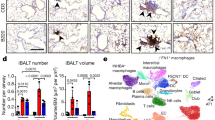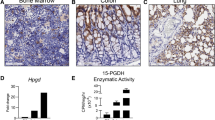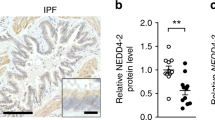Abstract
In cystic fibrosis, dysregulated neutrophilic inflammation and chronic infection lead to progressive destruction of the airways. The underlying mechanisms have remained unclear. Lipoxins are anti-inflammatory lipid mediators that modulate neutrophilic inflammation. We report here that lipoxin concentrations in airway fluid were significantly suppressed in patients with cystic fibrosis compared to patients with other inflammatory lung conditions. We also show that administration of a metabolically stable lipoxin analog in a mouse model of the chronic airway inflammation and infection associated with cystic fibrosis suppressed neutrophilic inflammation, decreased pulmonary bacterial burden and attenuated disease severity. These findings suggest that there is a pathophysiologically important defect in lipoxin-mediated anti-inflammatory activity in the cystic fibrosis lung and that lipoxins have therapeutic potential in this lethal autosomal disease.
This is a preview of subscription content, access via your institution
Access options
Subscribe to this journal
Receive 12 print issues and online access
$209.00 per year
only $17.42 per issue
Buy this article
- Purchase on SpringerLink
- Instant access to full article PDF
Prices may be subject to local taxes which are calculated during checkout






Similar content being viewed by others
References
Welch, W.J., Ramsey, B.W., Accurso, F.J. & Cutting, G.R. in Metabolic and Molecular Bases of Inherited Disease (eds. Scriver, C.R. et al.) 521–588 (McGraw-Hill, New York, 2001).
Verkman, A.S., Song, Y. & Thiagarajah, J.R. Role of airway surface liquid and submucosal glands in cystic fibrosis lung disease. Am. J. Physiol. Cell Physiol. 284, C2–C15 (2003).
Khan, T.Z. et al. Early pulmonary inflammation in infants with cystic fibrosis. Am. J. Respir. Crit. Care Med. 151, 1075–1082 (1995).
Bonfield, T.L. et al. Inflammatory cytokines in cystic fibrosis lungs. Am. J. Respir. Crit. Care Med. 152, 2111–2118 (1995).
Muhlebach, M.S., Stewart, P.W., Leigh, M.W. & Noah, T.L. Quantitation of inflammatory responses to bacteria in young cystic fibrosis and control patients. Am. J. Respir. Crit. Care Med. 160, 186–191 (1999).
Noah, T.L., Black, H.R., Cheng, P.W., Wood, R.E. & Leigh, M.W. Nasal and bronchoalveolar lavage fluid cytokines in early cystic fibrosis. J. Infect. Dis. 175, 638–647 (1997).
Tirouvanziam, R. et al. Inflammation and infection in naive human cystic fibrosis airway grafts. Am. J. Respir. Cell Mol. Biol. 23, 121–127 (2000).
Muhlebach, M.S. & Noah, T.L. Endotoxin activity and inflammatory markers in the airways of young patients with cystic fibrosis. Am. J. Respir. Crit. Care Med. 165, 911–915 (2002).
Konstan, M.W., Walenga, R.W., Hilliard, K.A. & Hilliard, J.B. Leukotriene B4 markedly elevated in the epithelial lining fluid of patients with cystic fibrosis. Am. Rev. Respir. Dis. 148, 896–901 (1993).
McElvaney, N.G. et al. Aerosol α1-antitrypsin treatment for cystic fibrosis. Lancet 337, 392–394 (1991).
Rosenberg, H.F. & Gallin, J.I. in Fundamental Immunology 4th edn. (ed. Paul, W.E.) 1051–1066 (Lippincott-Raven, Philadelphia, 1999).
Serhan, C.N. Lipoxins and aspirin-triggered 15-epi-lipoxin biosynthesis: an update and role in anti-inflammation and pro-resolution. Prostaglandins Other Lipid Mediat. 69, 433–455 (2002).
Fierro, I.M. & Serhan, C.N. Mechanisms in anti-inflammation and resolution: the role of lipoxins and aspirin-triggered lipoxins. Braz. J. Med. Biol. Res. 34, 555–566 (2001).
Gewirtz, A.T. et al. Pathogen-induced chemokine secretion from model intestinal epithelium is inhibited by lipoxin A4 analogs. J. Clin. Invest. 101, 1860–1869 (1998).
Clish, C.B. et al. Local and systemic delivery of a stable aspirin-triggered lipoxin prevents neutrophil recruitment in vivo . Proc. Natl. Acad. Sci. USA 96, 8247–8252 (1999).
van Heeckeren, A.M. & Schluchter, M.D. Murine models of chronic Pseudomonas aeruginosa lung infection. Lab Anim. 36, 291–312 (2002).
Costerton, J.W. Cystic fibrosis pathogenesis and the role of biofilms in persistent infection. Trends Microbiol. 9, 50–52 (2001).
Stotland, P.K., Radzioch, D. & Stevenson, M.M. Mouse models of chronic lung infection with Pseudomonas aeruginosa: models for the study of cystic fibrosis. Pediatr. Pulmonol. 30, 413–424 (2000).
Bonnans, C. et al. Lipoxins are potential endogenous antiinflammatory mediators in asthma. Am. J. Respir. Crit. Care Med. 165, 1531–1535 (2002).
Sanak, M. et al. Aspirin-tolerant asthmatics generate more lipoxins than aspirin-intolerant asthmatics. Eur. Respir. J. 16, 44–49 (2000).
Hopen, U.E., Lu, B., Gerard, N.P. & Gerard, C. The C5a chemoattractant receptor mediates mucosal defense to infection. Nature 383, 25–26 (1996).
Bonnans, C., Mainprice, B., Chanez, P., Bousquet, J. & Urbach, V. Lipoxin A4 stimulates a cytosolic Ca2+ increase in human bronchial epithelium. J. Biol. Chem. 278, 10879–10884 (2003).
Pilewski, J.M. & Frizzell, R.A. Role of CFTR in airway disease. Physiol. Rev. 79, S215–S255 (1999).
Serhan, C.N., Levy, B.D., Clish, C.B., Gronert, K. & Chiang, N. Lipoxins, aspirin triggered 15-epi-lipoxin stable analogs and their receptors in anti-inflammation: a window for therapeutic opportunity. Ernst Schering Res. Found. Workshop 31, 143–185 (2000).
Levy, B.D., Clish, C.B., Schmidt, B., Gronert, K. & Serhan, C.N. Lipid mediator class switching during acute inflammation: signals in resolution. Nat. Immunol. 2, 612–619 (2001).
Xu, Y. et al. Transcriptional adaptation to cystic fibrosis transmembrane conductance regulator deficiency. J. Biol. Chem. 278, 7674–7682 (2003).
Hong, S., Gronert, K., Devchand, P.R., Moussignac, R.L. & Serhan, C.N. Novel docosatrienes and 17S-resolvins generated from docosahexaenoic acid in murine brain, human blood, and glial cells. Autacoids in anti-inflammation. J. Biol. Chem. 278, 14677–14687 (2003).
Serhan, C.N. et al. Novel functional sets of lipid-derived mediators with antiinflammatory actions generated from omega-3 fatty acids via cyclooxygenase 2-nonsteroidal antiinflammatory drugs and transcellular processing. J. Exp. Med. 192, 1197–1204 (2000).
Serhan, C.N. et al. Resolvins: a family of bioactive products of omega-3 fatty acid transformation circuits initiated by aspirin treatment that counter proinflammation signals. J. Exp. Med. 196, 1025–1037 (2002).
Freedman, S.D., Shea, J.C., Blanco, P.G. & Alvarez, J.G. Fatty acids in cystic fibrosis. Curr. Opin. Pulm. Med. 6, 530–532 (2000).
Freedman, S.D. et al. Association of cystic fibrosis with abnormalities in fatty acid metabolism. N. Engl. J. Med. 350, 560–569 (2004).
Gronert, K., Gewirtz, A., Madara, J.L. & Serhan, C.N. Identification of a human enterocyte lipoxin A4 receptor that is regulated by interleukin (IL)-13 and interferon γ and inhibits tumor necrosis factor α-induced IL-8 release. J. Exp. Med. 187, 1285–1294 (1998).
Gronert, K., Martinsson-Niskanen, T., Ravasi, S., Chiang, N. & Serhan, C.N. Selectivity of recombinant human leukotriene D4, leukotriene B4, and lipoxin A4 receptors with aspirin-triggered 15-epi-LXA4 and regulation of vascular and inflammatory responses. Am. J. Pathol. 158, 3–9 (2001).
Sarau, H.M. et al. Identification, molecular cloning, expression, and characterization of a cysteinyl leukotriene receptor. Mol. Pharmacol. 56, 657–663 (1999).
Lynch, K.R. et al. Characterization of the human cysteinyl leukotriene CysLT1 receptor. Nature 399, 789–793 (1999).
Wills-Karp, M. et al. Interleukin-13: central mediator of allergic asthma. Science 282, 2258–2261 (1998).
Gewirtz, A.T. et al. Lipoxin A4 analogs attenuate induction of intestinal epithelial proinflammatory gene expression and reduce the severity of dextran sodium sulfate-induced colitis. J. Immunol. 168, 5260–5267 (2002).
Andrews, P.C. & Krinsky, N.L. Quantitative determination of myeloperoxidase using tetramethylbenzidine as substrate. Anal. Biochem. 127, 346–350 (1982).
Acknowledgements
We thank A. van Heeckeren for providing P. aeruginosa strain M57-15. Supported by the Cystic Fibrosis Foundation (KARP01G0, NCRR M01 RR00069, and the Johns Hopkins and Cincinnati Children's Hospital Medical Center CF Research Development Program Centers).
Author information
Authors and Affiliations
Corresponding author
Ethics declarations
Competing interests
The authors declare no competing financial interests.
Rights and permissions
About this article
Cite this article
Karp, C., Flick, L., Park, K. et al. Defective lipoxin-mediated anti-inflammatory activity in the cystic fibrosis airway. Nat Immunol 5, 388–392 (2004). https://doi.org/10.1038/ni1056
Received:
Accepted:
Published:
Issue Date:
DOI: https://doi.org/10.1038/ni1056



